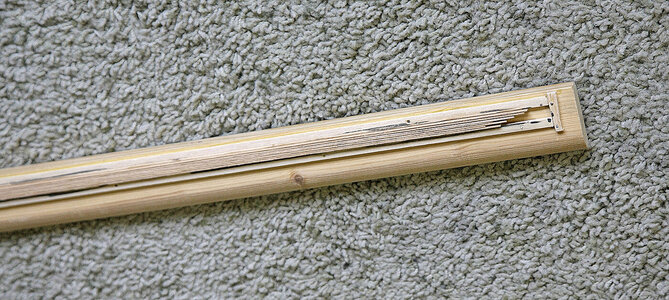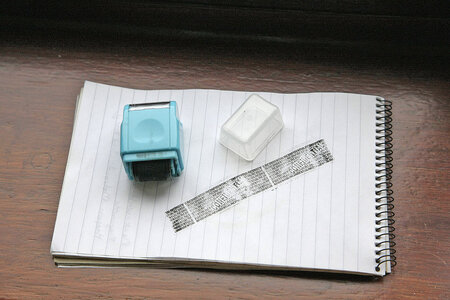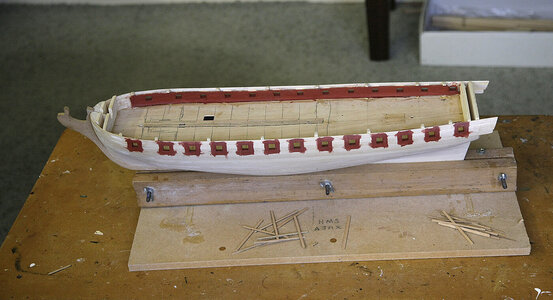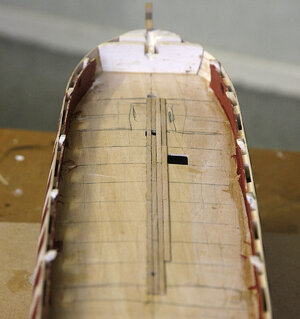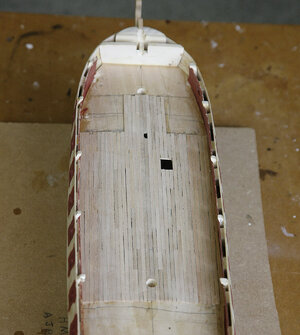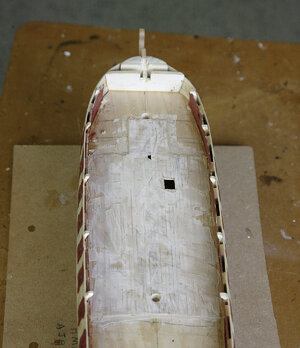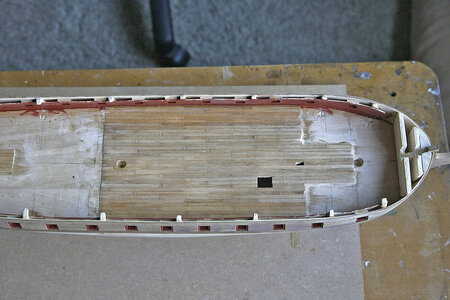Hi Pete,
good to see you come across from the other forum. Welcome.
good to see you come across from the other forum. Welcome.


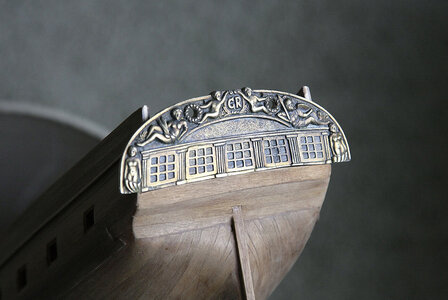
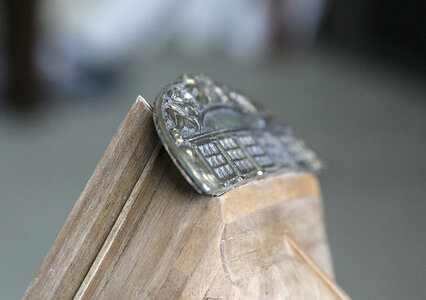
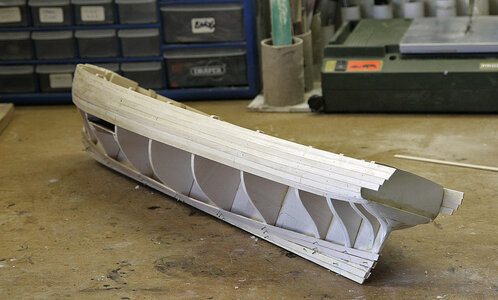
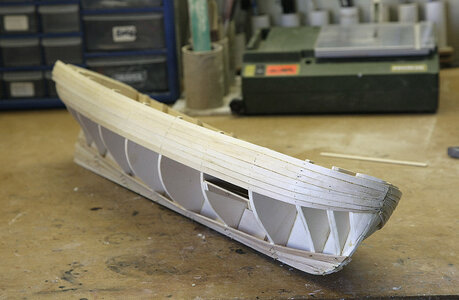
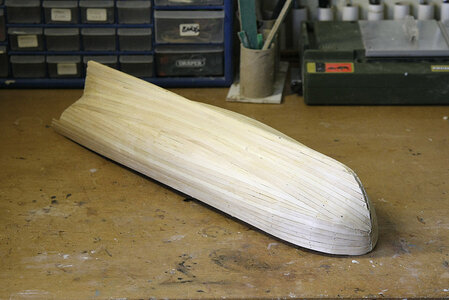
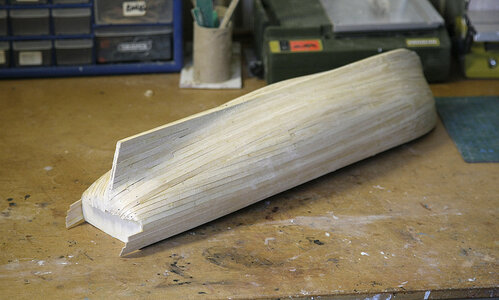
Looks fantastic. Not very much if any filler needed.Hello Everyone. Here we go again so thanks for your likes. The posts are coming fairly quickly in an attempt to catch up as I’m building almost as fast as I’m posting. I’m enjoying the build so much that I can’t leave it alone, I don’t know why that should be as it’s not the perfect kit, maybe it’s the involvement that it demands makes it more personal.
I’m glad that Peter is now with us on this forum as his knowledge and willingness to help is a great asset. I know Peter from my time with MSW and my building of the Royal William, I mentioned earlier that I had a lot of assistance without which I wouldn’t have got very far without. He is a retired teacher and he just does his helpline as a hobby.
The detailed explanation that he gave was interesting, I thought though that it was tricky, not easy to make and overcomplicated for a kit but it was at least method. I like to keep things as simple as possible provided that I get the right outcome. In this respect I think that my idea was much easier, it turned out to be more accurate than I could have made it joining all those pieces together and it took less than an hour to do including the planking. I’ve jumped ahead with my pictures to show you the nearly finished result. The casting is only resting in place and all the detailing still needs to be done but you’ll get the idea.
I have finished the initial stage of the first planking, it went ok with no issues and I think it turned out reasonable, it now needs a good sanding.
View attachment 213820
View attachment 213821
View attachment 213826
View attachment 213823
View attachment 213824
View attachment 213825

Hi Jeff. Thanks for noticing, I always try and get a good surface on my first planking it gives a feel for the flow of the hull for the second planking. It will need just a little filler before sanding, not to correct the shape but there are some small gaps, it will look much better after a good sanding.Looks fantastic. Not very much if any filler needed.
From the first pictures of the stern, it looks like you have already completed the second planking!Hi Jeff. Thanks for noticing, I always try and get a good surface on my first planking it gives a feel for the flow of the hull for the second planking. It will need just a little filler before sanding, not to correct the shape but there are some small gaps, it will look much better after a good sanding.

Hi Dean. Yes the second planking is done, I took that picture yesterday as I wanted to show how the stern had come out. As I said I started to build Ajax almost as soon as I got the kit, I hadn’t really intended to but it just happened, as it does. I hadn’t finished the Riva by then and didn’t want to be doing two builds and two logs at the same time so I left doing the Ajax log until later thinking that it would be easy to catch up, I’m usually a fast builder especially when I enjoy the project but I hadn’t realised how quickly I would be doing this build, perhaps it is in direct proportion with the amount of pleasure that it’s giving. I’ll hopefully catch up soon unless something else comes up to divert my attention.From the first pictures of the stern, it looks like you have already completed the second planking!

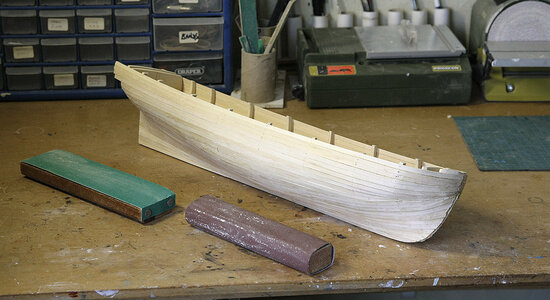
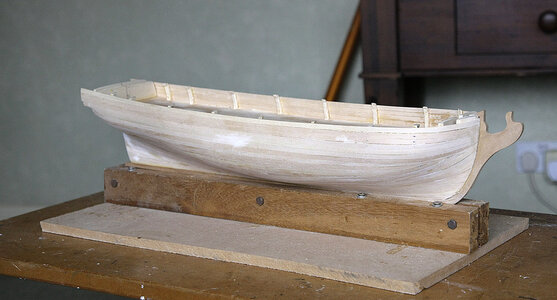
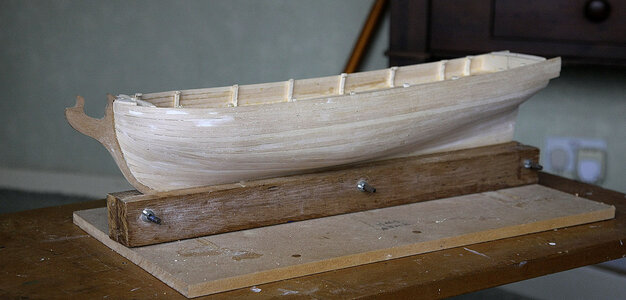
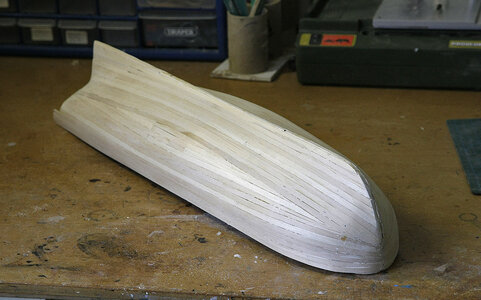
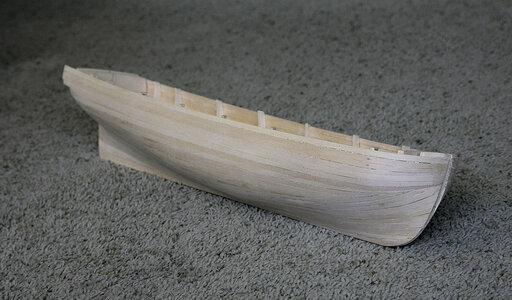
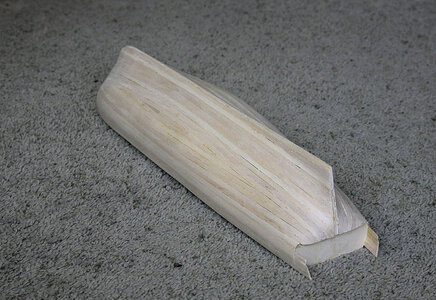
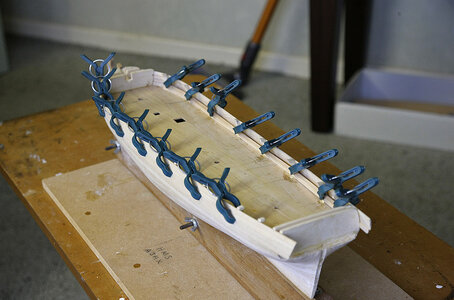
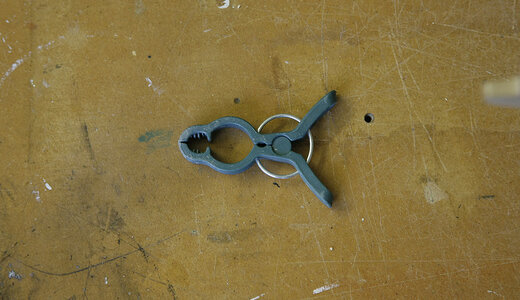
Hi Pete,Hi Ken (and to all who read this),
Euromodel is very much in business - in spite of what may have been stated on this website and other websites - and that has been an unfortunate turn of events for their company. Perhaps the moderators of this website could rectify that problem. Euromodel have never stated that comment themselves and let me assure you I am not speaking on their behalf - far from it !
Now, to introduce myself. My name is piratepete and I have been a contributor to MSW and failed to realise the significance of this particular forum ... my loss (up till now). I was placed in the fortunate position of being able to post my Euromodel build logs onto the Euromodel website. This has taken an enormous amount of my time over the past years and have concentrated on ships such as the Royal William, Friederich Wilhelm, La Renommee and the Lyde. For personal reasons, Euromodel gifted me every kit in their range and in return I continue to add postings to their site. However, I have no commercial link with them and receive no reward of any kind for doing this work. I just love editing and publishing and that is my passion in life. Files are freely available for anybody to copy.
Over the years, I have become well versed in all aspects of the Euromodel drawings and am more than happy to make any comments or suggestions should they arise (I can see no mechansim on this website for personal, private messages as well as a following mechanism to receive notifications of added comments but perhaps somebody can enlighten me).
The consequence of doing this work means that some ships, such as the Ajax, have been neglected although some preliminary work has been done on the hull construction and files have been completed in this respect.
So ... back to Ken directly. I have included just one diagram and its explanatory notes from one of my pdf files. If that interests and/or helps you, I am quite happy to talk further.
Fig. 55 shows a number of important features …View attachment 213729
piratepete
- the filler blocks 16 &17 (shaded blue)
- the bottom of the tiller opening in the metal piece is flush with the bottom of the laser-cut hole in Frame 2
- the maximum thickness of the filler blocks should be 5.3 mm.
- the metal piece (shaded yellow) sits out slightly from the filler blocks to allow for planking thickness
- the supplied block 5 x 15 x 140 mm. (shaded green) supports the transom metal casting above it. This will only allow a simple curved to be created. It was decided on following the true intent of the drawing by forming a compound curve and so increased the thickness by 3 mm. behind it.
- timber packing blocks (shaded brown) were used for a fixing point between Frame 2 and the transom support & lower metal piece – the block positioning looked a little different but the outcome was the same (Fig. 55)

Hi Maarten,Hi Ken,
See you have a complete ship production site. Love the Euromodel kits, seems they are more detailed then many of the kits of other larger companies.

Hi Maarten,Hi Pete,
Can you post pictures of your Euromodel ships in the finished model section? Allways interested as we don't see a lot of Euromodel kits build.
Maybe an idea for Euromodel to be more active on forums like ours, we do have more and more kit manufacturers joining here.
If they are interested they could contact @Donnie or @zoly99sask.



Hi Pete, I’m going to do the full opening and make up the rudder and mount it as per plan, when I get to that point in my log I’ll show a full set of picturesKen,
On reflection of the above odd question, what I should have said was ... are you just putting the rudder in position and perhaps showing a dummy aft representation of the tiller arm or putting in an actual opening for the tiller arm along with the rudder ? Hope that makes better sense.
Pete

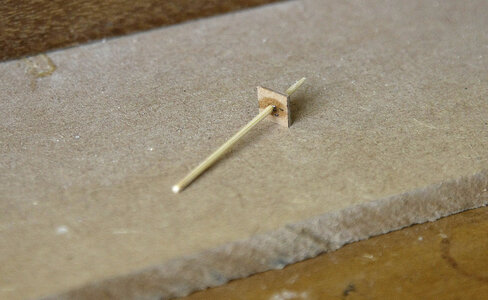
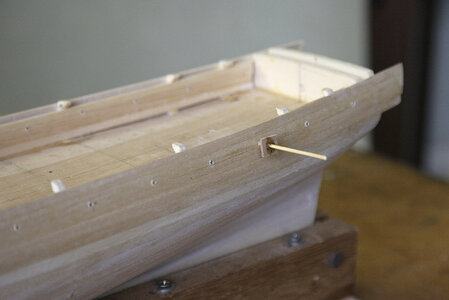
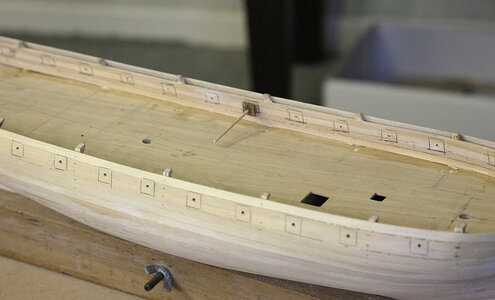
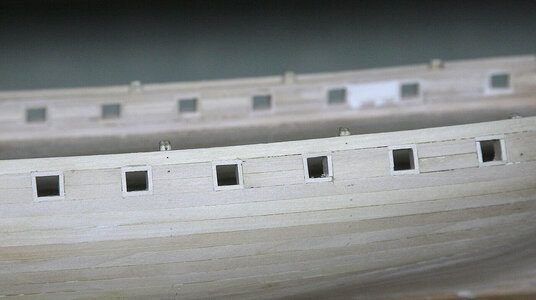
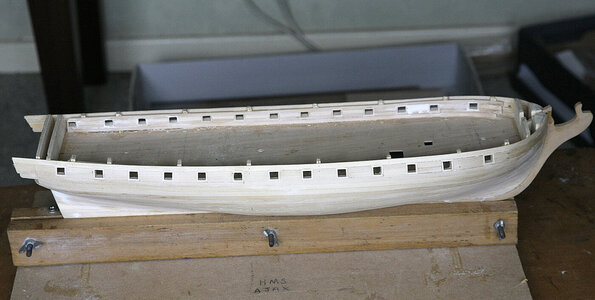
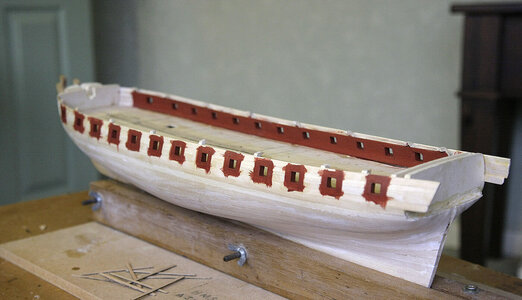
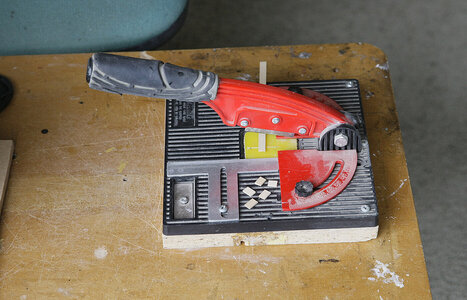
Beautifully accomplished, Ken. I accidently did mine the same way (accidently because I really have no idea what I am doing). That's a first for me! That's a very robust guillotine. Who is the manufacturer?Hello Everyone, Thanks to those that have contributed to my log.
As I previously mentioned today’s post will be the main gun ports. These are measured up and cut out according to the plan. The more recent method introduced by the manufacturers is for ply sides with pre cut ports, this sounds like a good idea that simplifies the process, but reading logs I notice that due to small errors that creep into a build these pre cut ports end up not always being in the right place, or that the canons don’t pass through their centre making the need for corrections to be made that often take longer than making your own ports originally. Having a good accurate plan makes it easy to get them right first time, this is where Euromodel comes into its own with its 1:1 plans, you can also see if the canons are sited correctly and not foul anything.
I made up a canon so that I could check my ports for the correct height for the barrels to pass through their centre. Next I made up a simple template for drawing the port size onto the hull, I mark off the positioning of the ports according to the plan, I use the canon to mark where the barrel will pass through and drill a hole through the hull side. I place the template into that hole and draw in the port. I use a scalpel to cut them out, I use a new blade for each side to get a good clean cut, a straight pointy blade for down cutting across the grain and a curved one along the top, a pointy one will tend to follow the grain and it’s difficult to get a straight cut. It only takes about four passes to cut down and one pass will do across, you will end up with a very clean accurate cut. I found that this way was much easier and more precise than drilling around the edges and sanding. I then lined them with 6mm x 1mm lime. As the ports had been cut the same I was able to cut a stack of lining pieces the correct size on my guillotine and have them at hand, I glued them in using white glue. I sanded them flush with the hull and inner walls, I gave them a coat of sanding sealer and painted them using Caldercraft Dull Red. When the second planking is done it will leave a very neat edge with no overpaint.
View attachment 214398
View attachment 214399
View attachment 214400
View attachment 214401
View attachment 214402
View attachment 214403
View attachment 214404

Hi Paul. Thanks for your comment. The guillotine was nothing special, I bought it from eBay ‘Craft Guillotine’ I see that it’s still sold, it is £13 Including postage, I screwed on a wooden base to give it some solidity and heft, I put on an old cycle bar grip for more comfort and the aluminium cutting guide is home made. It cuts cleanly up to 4mm, it’s great for repeat cutting like deck planks, it earns its place on my benchBeautifully accomplished, Ken. I accidently did mine the same way (accidently because I really have no idea what I am doing). That's a first for me! That's a very robust guillotine. Who is the manufacturer?


